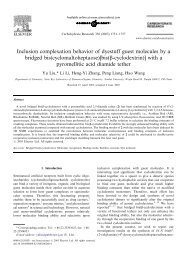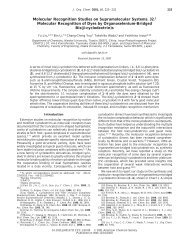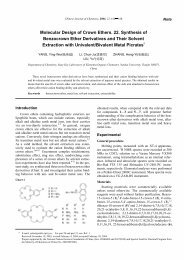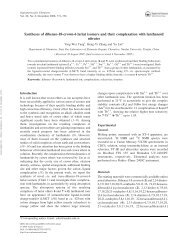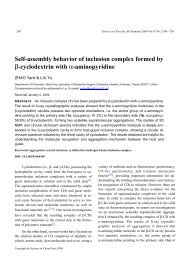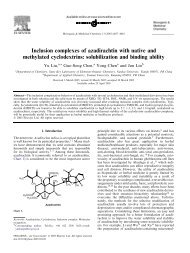Complexation Thermodynamics of Crown Ethers. 6.1,2 Calorimetric ...
Complexation Thermodynamics of Crown Ethers. 6.1,2 Calorimetric ...
Complexation Thermodynamics of Crown Ethers. 6.1,2 Calorimetric ...
Create successful ePaper yourself
Turn your PDF publications into a flip-book with our unique Google optimized e-Paper software.
2144 J. Org. Chem. 1998, 63, 2144-2147<strong>Complexation</strong> <strong>Thermodynamics</strong> <strong>of</strong> <strong>Crown</strong> <strong>Ethers</strong>. 6. 1,2<strong>Calorimetric</strong> Titration <strong>of</strong> Cation <strong>Complexation</strong> with SomeAzacrown <strong>Ethers</strong>Yu Liu,* ,† Bao-Hang Han, † Yoshihisa Inoue,* ,‡ and Mikio Ouchi §Department <strong>of</strong> Chemistry, Nankai University, Tianjin, 300071, China, Department <strong>of</strong> MolecularChemistry, Faculty <strong>of</strong> Engineering, Osaka University, Yamadaoka, Suita 565, Japan, and Department <strong>of</strong>Applied Chemistry, Himeji Institute <strong>of</strong> Technology, Shosha, Himeji 671-22, JapanReceived September 3, 1997Complex stability constants (K s ) and thermodynamic parameters (∆H° and ∆S°) were determinedin methanol at 25 °C for the stoichiometric 1:1 complexation <strong>of</strong> some alkali metal ions (Na + ,K + ,and Cs + ) with N-phenylaza-15-crown-5 (1), N-octylaza-15-crown-5 (2), and N-benzylaza-15-crown-5to N-benzylaza-24-crown-8 (3-6). The N-substituent was shown to have a drastic effect uponcomplex stability <strong>of</strong> the aza-15-crown-5 series (1-3). The aza-15-crown-5 2 possessing the leastbulkysubstituent afforded the most stable complexes with all cations examined and the highestNa + /K + selectivity up to 13. The larger-sized azacrown ethers 4-6 gave the highest complexstabilities for the size-matched cations; i.e., 4 showed the highest K + /Cs + selectivity up to 40, while6 showed the highest Cs + /K + selectivity <strong>of</strong> 10. These results indicate that the N-substituent playscrucial roles in addition to the size-fit concept in the complexation <strong>of</strong> azacrown ethers with anondonating side-chain. Thermodynamically, the complexation <strong>of</strong> alkali metal ions with azacrownethers is enthalpy-driven, but the cation selectivity is mostly entropy-governed in methanol.IntroductionSince the first synthesis <strong>of</strong> crown ethers with sidechain(s)attached through a carbon- or nitrogen-pivot,thermodynamic studies on the complexation <strong>of</strong> lariatethers with cations were performed in order to elucidatethe nature <strong>of</strong> the cation-binding behavior from a thermodynamicpoint <strong>of</strong> view and also to gain insight intothe factors governing cation-ligand complexation phenomena.3-7 Lariat ethers with additional binding sitesin the side-chain(s) are known to give significantlyenhanced cation-binding ability and selectivity as comparedwith the parent crown ether. 8-15†Nankai University.‡Osaka University.§Himeji Institute <strong>of</strong> Technology.(1) Part 4, Liu, Y.; Zhang, L.-J.; Li, Y.-M.; Chen, Y.-T.; Huang, S.;Meng, J.; Inoue, Y.; Ouchi, M. Thermochim. Acta 1995, 253, 93. Part5, Liu, Y.; Li, Y.-M.; Zhang, L.-J.; Chen, Y.-T.; Ouchi, M.; Inoue, Y. J.Chem. Res. (S) 1996, 216; (M) 1996, 1147.(2) Molecular Design <strong>of</strong> <strong>Crown</strong> <strong>Ethers</strong>. Part 15; for Part 13, see Liu,Y.; Han, B.-H.; Li, Y.-M.; Chen, R.-T.; Ouchi, M.; Inoue, Y. J. Phys.Chem. 1996, 100, 17361.(3) Davidson, R. B.; Izatt, R. M.; Christensen, J. J.; Schultz, R. A.;Dishong, D. M.; Gokel, G. W. J. Org. Chem. 1984, 49, 5080.(4) Matthes, K. E.; Parker, D.; Buschmann, H. J.; Ferguson, G.Tetrahedron Lett. 1987, 28, 5573.(5) Arnold, K. A.; Echegoyen, L.; Gokel, G. W. J. Am. Chem. Soc.1987, 109, 3713.(6) Adamic, R. J.; Eyring, E. M.; Petrucci, S.; Bartsch, R. A. J. Phys.Chem. 1985, 89, 3752.(7) Adamic, R. J.; Lloyd, B. A.; Eyring, E. M.; Petrucci, S.; Bartsch,R. A.; Pugia, M. J.; Knudsen, B. E.; Liu, Y.; Desai, D. H. J. Phys. Chem.1986, 90, 6571.(8) Gokel, G. W.; Dishong, D. M.; Diamond, C. J. J. Chem. Soc.,Chem. Commun. 1980, 1053.(9) Schultz, R. A.; Dishong, D. M.; Gokel, G. W. J. Am. Chem. Soc.1982, 104, 625.(10) Kaifer, A.; Echegoyen, L.; Gustowski, D. A.; Goli, D. W.; Gokel,G. W. J. Am. Chem. Soc. 1983, 105, 7168.(11) Nakatsuji, Y.; Nakamura, T.; Yonetani, M.; Yuya, H.; Okahara,M. J. Am. Chem. Soc. 1988, 110, 531.(12) Nakatsuji, Y.; Wakita, R.; Harada, Y.; Okahara, M. J. Org.Chem. 1989, 54, 2988.We have shown that the introduction <strong>of</strong> both nondonatingalkyl 16 and donating oxyethylene group(s) 17 to thecarbon-pivot 16-crown-5 alter not only the cation-bindingconstant but also the relative cation selectivity significantly.More recently, we have demonstrated that thecarbon-pivot lariats are less flexible in adjusting theirconformations upon complexation than the correspondingnitrogen-pivot lariats. 2,18 The relevant thermodynamicquantities clearly indicate that the binding ability andselectivity <strong>of</strong> lariat ethers are governed by the ligand’scavity size, the type and number <strong>of</strong> additional donoratom(s) in the side-chain, and the pivot atom. However,less attention has been paid to the complexation thermodynamics<strong>of</strong> azacrown ethers with nondonating sidechain(s).In particular, the influence <strong>of</strong> substitution andring size on the cation-binding ability/selectivity <strong>of</strong> azacrownethers has not been investigated systematicallyfrom a thermodynamic point <strong>of</strong> view, despite the potentialimportance <strong>of</strong> such studies in discussing the complexationbehavior <strong>of</strong> lariat ethers.In the present study, we report our results <strong>of</strong> athermodynamic study on the complexation <strong>of</strong> alkali metalions (Na + ,K + , and Cs + ) with N-phenyl-aza-15-crown-5(1), N-octylaza-15-crown-5 (2), and N-benzylaza-15-crown-5 (3), N-benzylaza-18-crown-6 (4), N-benzylaza-21-crown-7 (5), and N-benzylaza-24-crown-8 (6) (Chart 1) inmethanol at 25 °C. In this study, we discuss the(13) Dishong, D. M.; Diamond, C. J.; Gokel, G. W. Tetrahedron Lett.1981, 22, 1663.(14) Schultz, R. A.; Dishong, D. M.; Gokel, G. W. Tetrahedron Lett.1981, 22, 2623.(15) Kaifer, A.; Echegoyen, L.; Gustowski, D. A.; Goli, D. M.; Gokel,G. W. J. Am. Chem. Soc. 1983, 105, 6717.(16) Inoue, Y.; Wada, K.; Liu, Y.; Ouchi, M.; Tai, A.; Hakushi, T. J.Org. Chem. 1989, 54, 5268.(17) Liu, Y.; Tong, L.-H.; Inoue, Y.; Hakushi, T. J. Chem. Soc., PerkinTrans. 2 1991, 1725.(18) Ouchi, M.; Liu, Y.; Tanizaki, S.-I.; Tong, L.-H.; Hakushi, T.Chem. Express 1992, 8, 777.S0022-3263(97)01634-4 CCC: $15.00 © 1998 American Chemical SocietyPublished on Web 03/04/1998
<strong>Complexation</strong> <strong>Thermodynamics</strong> <strong>of</strong> <strong>Crown</strong> <strong>Ethers</strong> J. Org. Chem., Vol. 63, No. 7, 1998 2145Chart 1 Table 1. Complex Stability Constant (log K s) andThermodynamic Parameters (in kcal/mol) for<strong>Complexation</strong> <strong>of</strong> Alkali Metal Ions with Azacrown <strong>Ethers</strong>1-6 in Methanol at 25 °Cinfluence <strong>of</strong> the substitution and ring size upon complexation<strong>of</strong> azacrown ethers with cations from the thermodynamicpoint <strong>of</strong> view. The thermodynamic quantitiesobtained will provide further understanding <strong>of</strong> the complexationbehavior <strong>of</strong> azacrown ethers with a nondonatingside-chain.crownether lanthanoid log K s -∆G° -∆H° T∆S° ref1 Na + 1.80 ( 0.03 2.46 6.52 ( 0.07 -4.06 aK + 1.72 ( 0.03 2.35 8.15 ( 0.05 -5.80 a2 Na + 3.31 ( 0.06 4.27 4.63 ( 0.08 -0.36 aK + 2.20 ( 0.07 3.00 11.69 ( 0.09 -8.69 aCs + 2.06 ( 0.02 2.81 5.86 ( 0.03 -3.05 b3 Na + 2.49 ( 0.03 3.40 6.62 ( 0.06 -3.22 bK + 1.83 ( 0.03 2.50 15.12 ( 0.12 -12.62 bCs + 1.37 ( 0.03 1.87 15.74 ( 0.06 -13.87 b4 Na + 3.57 ( 0.03 4.87 5.89 ( 0.09 -1.02 bK + 5.00 ( 0.07 6.82 11.27 ( 0.14 -4.45 bCs + 3.39 ( 0.06 4.62 11.84 ( 0.05 -7.22 b5 Na + 2.00 ( 0.08 2.73 3.66 ( 0.05 -0.93 bK + 4.67 ( 0.06 6.34 9.01 ( 0.07 -2.67 bCs + 3.97 ( 0.08 5.42 8.63 ( 0.04 -3.21 b6 Na + 1.67 ( 0.06 2.28 4.62 ( 0.03 -2.34 bK + 2.66 ( 0.03 3.63 10.73 ( 0.04 -7.10 bCs + 3.65 ( 0.06 4.98 9.71 ( 0.07 -4.73 ba Reference 1. b This work; values are the averages <strong>of</strong> more thanthree independent measurements.Experimental SectionMaterials. Azacrown ethers 1-6 were prepared accordingto the procedures reported previously. 18-20 Reagent-grademethanol was refluxed over magnesium turnings and thendistilled fractionally to give dry methanol for calorimetry.Analytical grade sodium chloride, potassium thiocyanate, andcesium chloride were used as received. All metal salts weredried in vacuo prior to use. The ligands 1-6 were dissolvedin the purified methanol to make a titrate solution <strong>of</strong> 3.0-6.0mM concentration, while the alkali metal salts were dissolvedin the same solvent to make a titrant solution in 0.12-0.15 Mconcentration.Apparatus and Procedures. <strong>Calorimetric</strong> titrations wereperformed at the atmospheric pressure in a temperaturecontrolledwater bath maintained at 25.0 °C by using an LKB-8721-2 precision titration calorimeter connected to a personalcomputer for automated titration and data processing. 1 Theprinciple <strong>of</strong> measurement and the detailed experimentalprocedures were reported elsewhere. 21,22 In a typical run, asolution <strong>of</strong> alkali metal salt (0.12-0.15 M) was continuouslyintroduced at a rate <strong>of</strong> 0.43 mL/min into a solution <strong>of</strong> azacrownether (1-6) (3.0-6.0 mM) placed in the calorimeter. To obtainthe net heat <strong>of</strong> complexation (Q net), the total apparent heatobserved (Q obs) was corrected for the dilution <strong>of</strong> titrant (Q D),the nonchemical contributions (Q HL), including agitation, heatflow between the vessel and its surrounding, and resistanceheating by the thermistor used, and the temperature differencebetween titrant and titrate (Q TC) in each run: Q net ) Q obs -Q D - Q HL - Q TC. A titration curve was obtained by plottingthe temperature change (measured by voltage) against theamount <strong>of</strong> the azacrown ether solution added, from which thecomplex stability constant (K s) and the enthalpy change (∆H°)were directly calculated. Reliability <strong>of</strong> the whole system andthe calculation procedures were doubly checked as previously 1by comparison <strong>of</strong> the obtained thermodynamic data with thereported values 3,23 to give satisfactory results.(19) Schultz, R. A.; White, B. D.; Dishong, D. M.; Gokel, G. W. J.Am. Chem. Soc. 1985, 107, 6659.(20) Zhang, L.-J. Ph.D. Dissertation, Nankai University, 1994.(21) Liu, Y.; Tong, L.-H.; Huang, S.; Tian, B.-Z.; Inoue, Y.; Hakushi,T. J. Phys. Chem. 1990, 94, 2666.(22) Liu, Y.; Lu, T.-B.; Tan, M.-Y.; Inoue, Y.; Hakushi, T. J. Phys.Chem. 1993, 97, 4548.(23) (a) Hansen, L. D.; Lewis, E. R. J. Chem. Thermodyn. 1971, 3,35. (b) Buschmann, H.-J. J. Solution Chem. 1988, 17, 277. (c) Inoue,Y.; Hakushi, T.; Liu, Y.; Tong, L.-H.; Hu, J.; Zhao, G.-D.; Huang, S.;Tian, B.-Z. J. Phys. Chem. 1988, 92, 2371.ResultsAssuming the 1:1 stoichiometry for the complexation<strong>of</strong> alkali metal ions (M ) Na + ,K + , and Cs + )withtheazacrown ethers 1-6 (ACE in eq 1), the complex stabilityconstant (K s ) and the enthalpy change (∆H°) werecalculated by using the least-squares method to minimizethe U value (eq 2): 24,25K sACE + M w\x ACE‚M (1)mU(K s ,∆H°) ) ∑(Q t - ∆H° × N t ) 2 (2)t)1where Q t refers to the net heat <strong>of</strong> complexation measuredat time t in minutes, and N t denotes the amount in moles<strong>of</strong> the complex formed at time t and is directly related tothe complex stability constant K s .The stability constant K s and the enthalpy change ∆H°for the complexation <strong>of</strong> Na + ,K + , and Cs + with 1-6 werecalculated by computer simulation by continuously changingK s , i.e., N t , to minimize the U value. For each cationazacrownether combination, the measurement wasrepeated more than three times, and the U valueobtained was minimized satisfactorily in each case to givethe optimized set <strong>of</strong> K s and ∆H°. No serious deviationwas found in the fitting process, verifying the 1:1 stoichiometry<strong>of</strong> complexation as assumed above. The valuesobtained by the repeated measurements were averagedto give the complex stability constants and thermodynamicparameters with standard deviations (Table 1).DiscussionComplex Stability and Cation Selectivity. As canbe seen from Table 1, the complex stability constant,relative cation selectivity, and thermodynamic parametersfor the complexation reactions <strong>of</strong> alkali metal ions(24) Inoue, Y.; Hakushi, T.; Liu, Y.; Tong, L.-H.; Shen, B.-J.; Jin,D.-S. J. Am. Chem. Soc. 1993, 115, 475.(25) Inoue, Y.; Liu, Y.; Tong, L.-H.; Shen, B.-J.; Jin, D.-S. J. Am.Chem. Soc. 1993, 115, 10637.
2146 J. Org. Chem., Vol. 63, No. 7, 1998 Liu et al.Figure 1. Complex stability constants (K s) as a function <strong>of</strong>cation diameter for the complexation <strong>of</strong> azacrown ethers 1-6and 15-crown-5 (15C5), 18-crown-6 (18C6), and 21-crown-7(21C7) with alkali metal ions in methanol at 25 °C.with azacrown ethers 1-6 are evidently influenced byseveral factors, particularly the bulkiness and/or flexibility<strong>of</strong> the substituent introduced at the N-pivot andthe relative size between the ligand’s cavity and thecation’s diameter. The changing pr<strong>of</strong>ile <strong>of</strong> complexstability constant (K s ) is plotted against the cationdiameter in Figure 1. As a control, the data 28 for theparent 15-crown-5, 18-crown-6, and 21-crown-7 are alsoplotted in Figure 1.It is noted that, possessing similar cavity sizes, threeaza-15-crown-5 1-3 display completely different complexationbehavior, which may be attributed to thedifferent substituent introduced at the N-pivot. Since thesolvation energies for Na + to Cs + do not differ substantiallyeven in water, 26 these differences observed areconsidered to arise from the other factors. Although allthe aza-15-crown-5 derivatives show the inherent preferencefor Na + , the complex stability constant and therelative cation selectivity for Na + over K + are dramaticallyaffected by the N-substituent introduced. Interestingly,the N-octyl derivative 2 gives much higher log K svalues and Na + /K + selectivity than the phenyl and benzylanalogues 1 and 3 do. It is deduced therefore that thesteric hindrance around the N-pivot plays a definitive rolein determining the spacial arrangement and orientation<strong>of</strong> the crown’s donor atoms. Probably, the octyl groupinduces most favorable conformation for the size-matchedNa + , while the benzyl or phenyl substitution at theN-pivot leads to less favorable conformations. However,the effects <strong>of</strong> the steric hindrance do not appear to beserious for the larger cations. Thus, the extent <strong>of</strong>decrease in log K s for K + is much smaller than that forNa + with 2, which affords the highest Na + /K + selectivity,up to 13. In the case <strong>of</strong> the phenyl derivative 1, thereduced electron density <strong>of</strong> the nitrogen donor due to theelectron-withdrawing effect <strong>of</strong> the phenyl substituentmay be additionally responsible for its decreased complexstability.(26) Marcus, Y. Ion Solvation; Wiley: Chichester, 1985.(27) Gandour, R. D.; Fronczek, F. R.; Gotto, V. J.; Minganti, C.;Schultz, R. A.; White, B. D.; Arnold, K. A.; Mazzochi, D.; Miller, S. R.;Gokel, G. W. J. Am. Chem. Soc. 1986, 108, 4078.(28) Inoue, Y.; Liu, Y.; Tong, L.-H.; Ouchi, M.; Hakushi, T. J. Chem.Soc., Perkin Trans. 2 1993, 1947.In this context, it is interesting and somewhat puzzlingthat the parent aza-15-crown-5 without any steric hindrancearound the nitrogen atom gives the smallest logK s values <strong>of</strong> 1.70 and 1.60 for Na + and K + , respectively.19,27 Possibly, the parent aza-15-crown-5, withoutany N-substituent that can lock the ring conformation,suffers substantial conformational changes upon cationbinding, accompanying a considerable entropic loss thatdiminishes the complex stability.More consistent results were obtained with the N-benzylazacrown ethers <strong>of</strong> varying ring sizes. As can beseen from Figure 1, the 15-, 18-, 21-, and 24-memberedazacrown ethers (3, 4, 5, and 6) show the highest log K svalues for the size-matched cations, i.e., Na + ,K + , andCs + , respectively. However, the highest complex stabilityconstant for Na + was obtained not with aza-15-crown-53 but with aza-18-crown-6 4. One possible rationalizationwould be that the steric hindrance caused by the N-benzyl group makes the operation <strong>of</strong> strict size-fittingdifficult. Alternatively, the tendency <strong>of</strong> alkali metal ionsto form hexacoordinated complexes with crown ethers 19would also give the higher K s for crown-6 rather thancrown-5. 28 However, it is interesting that the increasedsteric hindrance in benzyl azacrown ethers enhances therelative cation selectivities for Na + , K + , and Cs + ascompared with the unsubstituted 15-crown-5 to 24-crown-8, 28 see Figure 1. The relative selectivities <strong>of</strong> Na + /K + for3 and K + /Cs + for 4 are 4.6 and 40.7, respectively, whileN-benzylaza-24-crown-8 (6) gives a high Cs + /K + selectivity<strong>of</strong> 9.8.Thermodynamic Parameters. To discuss the K sand relative cation selectivity from the thermodynamicpoint <strong>of</strong> view, thermodynamic quantities obtained areplotted in Figure 2. It is intriguing that all the enthalpychanges (∆H°) are negative and so are the entropychanges (∆S°). These results indicate that the complexation<strong>of</strong> azacrown ethers 1-6 with the alkali metal ionsexamined is driven predominantly by the favorableenthalpic gains, mostly originating from the strong iondipoleinteractions. However, the individual complexstability and cation selectivity are controlled primarilyby the entropic term, arising from the ligand’s conformationalchanges and the desolvation from both cationand ligand. Thus, the preferred binding ability <strong>of</strong> 2 forNa + is not the result <strong>of</strong> the largest enthalpic gain (-∆H°)but the smallest entropic loss (∆S°), and the othercation-ligand combinations exhibit quite similar thermodynamicbehavior, as can be observed from the datain Figure 2. Consequently, large enthalpic gain (-∆H°)does not immediately mean high complex stability andis <strong>of</strong>ten canceled by larger entropic loss (T∆S°), asexemplified by the complexation behavior <strong>of</strong> N-benzylaza-15-crown-5 (3) with K + and Cs + . Instead, the cationcrownether combinations with smaller entropic losseslead to higher complex stabilities.It is interesting to compare the thermodynamic parametersfor the complexation <strong>of</strong> a series <strong>of</strong> benzylazacrownethers 3-6 with K + and Cs + . As can be seen fromTable 1 and Figure 2, the enthalpy changes for K + andCs + are nearly equal to each other within
<strong>Complexation</strong> <strong>Thermodynamics</strong> <strong>of</strong> <strong>Crown</strong> <strong>Ethers</strong> J. Org. Chem., Vol. 63, No. 7, 1998 2147Figure 2. Thermodynamic parameters for the complexation<strong>of</strong> azacrown ethers 1-6 with alkali metal ions: (a) Na + , (b)K + , and (c) Cs + in methanol at 25 °C.for 6, afford much reduced entropic losses. The minimizedentropic loss may be rationalized by the fact thatthe size-fitted cation suffers more extensive desolvationupon complexation than the mismatched one, compensatingfor a substantial part <strong>of</strong> the inherent entropicdecrease from the complex formation.Another interesting thermodynamic feature is thechanging pr<strong>of</strong>ile <strong>of</strong> the ∆H° and ∆S° values observed forligands 3-6 and the compensation between these terms.For this series <strong>of</strong> ligands, the enthalpic gain (-∆H°) andthe entropic loss (T∆S°) obtained for ligands 3-6 increasesimultaneously with increasing cation diameter in acompensatory manner. This kind <strong>of</strong> enthalpy-entropycompensation effect has been observed widely in supramolecularinteractions and discussed earlier from amore global point <strong>of</strong> view. 24,25,29 In general, the larger(29) Inoue, Y.; Hakushi, T.; Liu, Y. In Cation Binding by Macrocycles;Inoue, Y., Gokel, G. W., Eds; Marcel Dekker: New York, 1990;Chapter 1.enthalpic gain leads to stronger host-guest interactionproducing a more rigid complex with reduced freedom,which entropically cancels the enthalpic gain at least inpart. In the present case, it is somewhat unexpectedhowever that the size-matched cation-ligand combinationsdo not necessarily give the largest enthalpic gains;see data for K + -4 and Cs + -6 combinations. Furthermore,it is a general tendency that the complexationswith larger cations (K + and Cs + ) afford greater enthalpicgains (and entropic losses), irrespective <strong>of</strong> the ligand’sring size. Typically, aza-15-crown-5 3 affords the largestenthalpic gain not with the size-matched Na + but withmuch larger-sized Cs + . A plausible explanation <strong>of</strong> thisgeneral tendency is that the complex formation <strong>of</strong> azacrownethers is not driven by equal participation <strong>of</strong> alldonor atoms but by preferential interaction with thenitrogen donor which is assisted by the oxygen donors.Hence, the interaction <strong>of</strong> a s<strong>of</strong>t nitrogen donor with s<strong>of</strong>tcations (K + and Cs + ) produces more heat (-∆H°) andaccompanying entropic loss (T∆S°) than a hard cation(Na + ).This simple idea may also explain the changing pr<strong>of</strong>ile<strong>of</strong> thermodynamic parameters obtained for the complexation<strong>of</strong> 3-6 with s<strong>of</strong>t cations. Regardless <strong>of</strong> the increasednumber <strong>of</strong> formal donor atoms, the enthalpic gainand entropic loss gradually decrease with the ligand’sincreasing size up to 21 and then increase to some extent(Figure 2). This behavior suggests that the oxygen atomsin smaller ligand are situated in the correct position and/or orientation to be suitable for cation binding and onlya limited number <strong>of</strong> oxygen atoms around the N-pivotcan coordinate to the cation accommodated in largerligands up to 21-crown-7, while the donor atoms in thelargest 24-crown-8 can wrap around the cation, showingrecovery in ∆H° and T∆S°.Acknowledgment. This work was supported byNational Outstanding Youth Fund (Grant No. 29625203)and National Natural Science Foundation <strong>of</strong> China(Grant No. 29672021), Trans-Century Training ProgramFoundation for the Talents <strong>of</strong> the State EducationCommission <strong>of</strong> China, and Natural Science Fund <strong>of</strong>Tianjin Municipality (Grant No. 953604811 and973602211), all <strong>of</strong> which are gratefully acknowledged.Supporting Information Available: <strong>Calorimetric</strong> titrationdata and detailed calculation procedures for the 1:1complexation <strong>of</strong> sodium chloride with N-benzylaza-18-crown-6(4) (4 pages). This material is contained in libraries onmicr<strong>of</strong>iche, immediately follows this article in the micr<strong>of</strong>ilmversion <strong>of</strong> the journal, and can be ordered from the ACS; seeany current masthead page for ordering information.JO9716340




